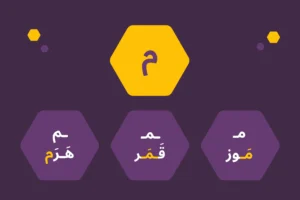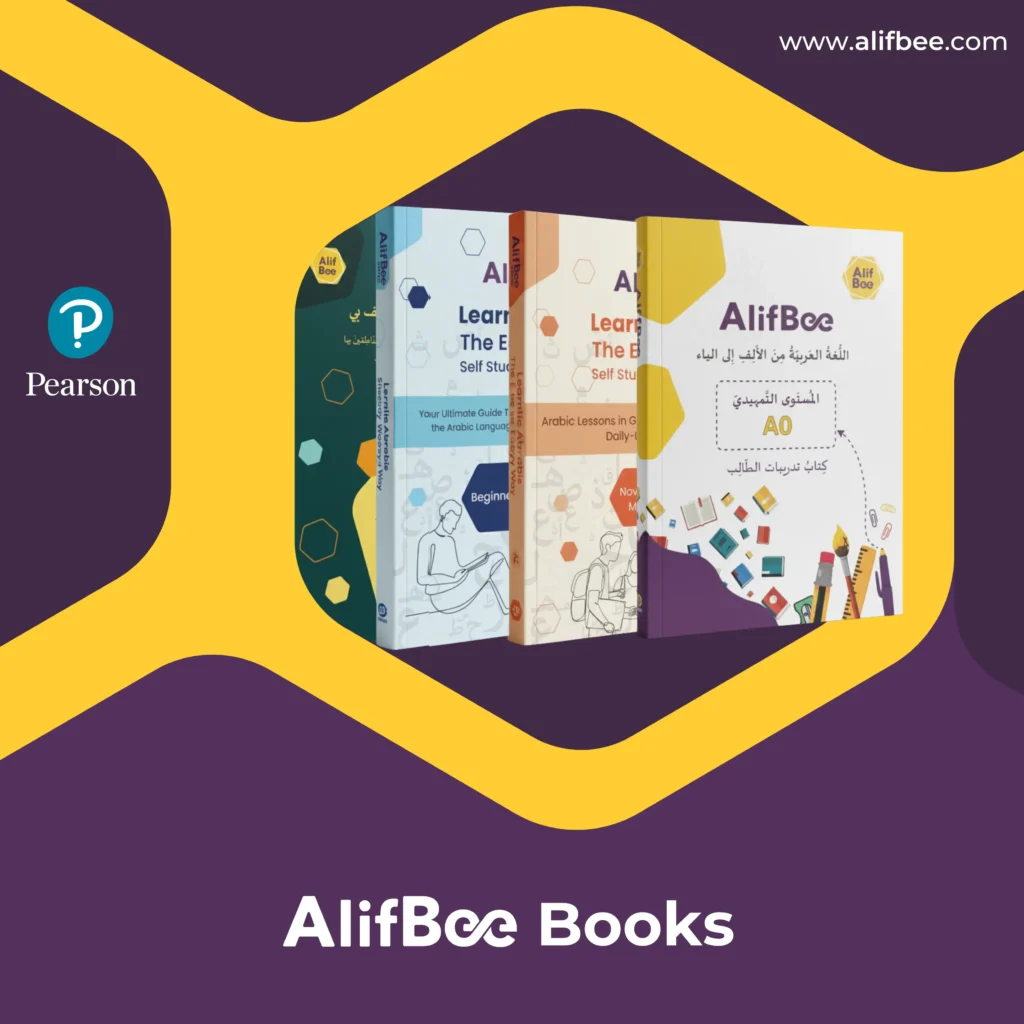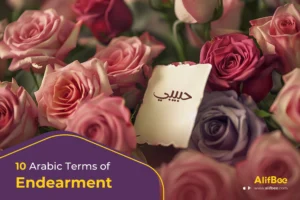
Learn the Arabic Alphabet: The Arabic Letter Meem (م)
Master the Arabic letter Meem (م)! Learn how to pronounce the meem phonetically and its forms. Explore Arabic words and master the Meem in Arabic.
Colors are a fun entry point when learning arabic: they are visual, practical and fairly easy to remember. Think about how many times a day you describe objects by their color. Probably too many to count! From cars to clothes, everyday conversations are littered with these adjectives, great for when you’re starting out and are fundamental in helping to widen your vocabulary.
Additionally, in the Arabic language, the words for color hold a deeper cultural significance. For example, green is a highly respected color in Islam, whereas gold represents splendor. Noting these important associations connects us to the more meaningful, emotive side of languages.
With that being said, in today’s article we will cover ten colors, touching upon specific points such as whether the word is masculine, feminine along with pronunciation, with plenty of examples and sentences as we go along!
Before we dive into the ten basic colors in Arabic, let’s discuss masculine and feminine color forms (as you will see below in the tables). Colors, being adjectives, must match the gender of the noun they are describing.
There are two main rules to make the feminine form of the color word.
The first way is to add Alif and Hamza ـاء (-āʼ) with a change in the pronunciation of the root. Here are some examples:
The other way is to add a vowel at the end of the word ـة (-ah / -ah sound), like:
So now, as we walk through the ten colors, hopefully you’ll be able to spot the differences between the masculine and feminine forms!
Red, symbolizing love and strong emotions.
English
Transliteration
Arabic
Red (masculine)
Aḥmar
أَحْمَر
Red (feminine)
Ḥamrāʼ
حَمْرَاء
Examples
He bought a red pen. (M)
Ishtará qalaman aḥmar
اشْتَرَى قَلَمًا أَحمَر
He rode in a red car. (F)
Rakiba sayyāratan ḥamrāʼ
رَكِبَ سَيَّارَةً حَمْرَاء
Yellow, and also gold, are used to describe brightness and wealth.
English
Transliteration
Arabic
Yellow (masculine)
Aṣfar
أَصْفَر
Yellow (feminine)
Ṣafrāʼ
صَفْرَاء
Examples
I saw the yellow sunflower. (M)
Raʼaytu ʻabbāda alshshamsi alʼaṣfar.
رَأَيْتُ عَبَّادَ الشَّمْسِ الأَصْفَر
He drew a yellow flower. (F)
Rasama wardatan ṣafrāʼ.
رَسَمَ وَرْدَةً صَفْرَاء
Blue can represent literal blue items such as the sea or sky, and also spiritual depth as well.
English
Transliteration
Arabic
Blue (masculine)
Azraq
أَزْرَق
Blue (feminine)
Zarqāʼ
زَرْقَاء
Examples
How beautiful the blue sea is! (M)
Mā ajmala albaḥara alʼazraq!
مَا أَجْمَلَ البَحَرَ الأَزْرَق!
Look at the blue sky. (F)
Unẓur lissamāʼi alzzarqāʼ.
انْظُرْ للسَّمَاءِ الزَّرْقَاء
Green, symbolizing nature, life and hope.
English
Transliteration
Arabic
Green (masculine)
Akhḍar
أَخْضَر
Green (feminine)
Khaḍrāʼ
خَضْرَاء
Examples
He saw a green orchard. (M)
Shāhada bustānan akhḍar.
شَاهَدَ بُسْتَانًا أَخْضَر
He visited a green garden. (F)
Zāra ḥadīqatan khaḍrāʼ
زَارَ حَدِيقَةً خَضْرَاء
The color black is powerful, and can also be seen as elegance or dignity.
English
Transliteration
Arabic
Black (masculine)
Aswad
أَسْوَد
Black (feminine)
Sawdāʼ
سَودَاء
Examples
He wore a black coat. (M)
Labisa miʻṭafan aswad.
لَبِسَ مِعْطَفًا أَسْوَد
He saw a black cat. (F)
Raʼá qiṭṭatan sawdāʼ.
رَأَى قِطَّةً سَودَاء
Gray can be linked with indecision.
English
Transliteration
Arabic
Gray (masculine)
Ramādī
رَمَادِي
Gray (feminine)
Ramādīyah
رَمَادِيَّة
Examples
She wore gray shoes. (M)
Labisat ḥidhāʼan ramādīananā.
لَبِسَتْ حِذَاءً رَمَادِيًّا
He took a gray bus. (F)
Istaqalla ḥāfilatan ramādyyatan.
اسْتَقَلَّ حَافِلَةً رَمَاديَّةً
Brown is an earthy color, one of stability and warmth.
English
Transliteration
Arabic
Brown (masculine)
Bunnī
بُنِّي
Brown (feminine)
Bunyyah
بُنْيَّة
Examples
He opened a brown door. (M)
Fataḥa bāban bunyyā.
فَتَحَ بَابًا بُنْيَّا
He carried a brown bag. (F)
Ḥamala ḥaqībatan bunyyah.
حَمَلَ حَقِيبَةً بُنْيَّة
Purity and peace are often associated with the color white.
English
Transliteration
Arabic
White (masculine)
Abyaḍ
أَبيَض
White (feminine)
Bayḍāʼ
بَيضاء
Examples
She wore a beautiful white dress. (M)
Irtadat fustānan abyḍa jamīlan.
ارتَدَتْ فُسْتَانًا أَبيضَ جَمِيلًا
He wrote on a white sheet of paper. (F)
Kataba ʻalá waraqatin bayḍāʼ.
كَتَبَ عَلَى وَرَقَةٍ بَيْضَاء
You might think of flowers, and also youth and softness when pink is mentioned.
English
Transliteration
Arabic
Pink (masculine)
Zahrī
زَهْرِي
Pink (feminine)
Zahrīyah
زَهْرِيَّة
Examples
He wore a pink shirt for the party. (M)
Irtadá qamīṣan zahrīananā llḥafl.
ارتَدَى قَمِيصًا زَهرِيًّا للحَفْل
She slept on a pink pillow. (F)
Nāmat ʻalá wsiādatin zahrīyah
نَامَت عَلَى وسِادَةٍ زَهْرِيَّة
Both violet and purple are often connected with nobility and luxury.
English
Transliteration
Arabic
Violet/purple (masculine)
Banafsajī
بَنَفْسَجِي
Violet/purple (feminine)
Banafsajīyah
بَنَفْسَجِيَّة
Examples
I brought a purple dress. (M)
Aḥḍartu fstānan banafsajīyan
أَحْضَرْتُ فستانًا بَنَفْسَجِيًّا
I love violet roses. (F)
Uḥibbu alwarda albanafsajī.
أحبُّ الوَرْدَ البَنَفْسَجِي
It doesn’t just stop with the ten colors in this article, why not take it a step further and get more specific with the colors you are describing!
The word for ‘light’: فاتح fātiḥ
The word for ‘dark’: غامق ghāmiq
These two words can then be combined with any of the colors to make your sentences a bit more detailed:
Light blue: “أزرق فاتح”
Dark green: “أخضر غامق”
Why not try these adjectives with the other colors…
I think we might be ready to put together some questions that you can ask when it comes to colors.
Of course, the first one that comes to mind:
Person A: What’s your favorite color? ما لونك المفضل؟
Person B: My favorite color is blue. لوني المفضل أزرق
Think of your own favorite color and swap it out for blue, and if you really want to step it up try adding ‘light’ (فاتح) and ‘dark’ (غامق) to the color of choice!
It is not surprising that colors are slightly different in Modern Standard Arabic (what is used in education, media and diplomacy for example) to dialects (what is used at home and with friends). This makes people who speak Arabic diglossic, meaning they can switch between the two.
Thinking about the Arabic dialects when it comes to colors, they may vary slightly in the usage of words. Egyptian, spoken in Egypt but widely understood, vocabulary often involves French and English borrowings, while Levantine Arabic (spoken in Lebanon, Syria, Jordan and Palestine), is softer and sometimes differs from colors in Egyptian Arabic. Gulf Arabic on the other hand, spoken in the Gulf countries, maintains some features of Classical/Modern Standard Arabic.
When it comes to colors, let’s take pink as an example:
So you can see that even though both are widely understood, it is important to note small differences here and there when it comes to the nuances within dialects.
So what’s the best way to learn and remember the colors in Arabic? Well, maybe the best way is to use what’s around you! You could label objects in your space, test yourself and perhaps try to use colors in sentences every day. See what strategy is the best for you, they can all help with memorizing vocabulary. Language learning is like building muscle, consistency is key and if you can a little bit every day, over time it all adds up!
As we’ve seen, colors are a great way to be descriptive and creative with language, and it is no different in Arabic! Add them into your daily life, whether you use them in questions, to be more specific or to add variety, this can really help build your vocabulary.
To continue learning Arabic, you can download our AlifBee App, a helpful assistant on your journey to mastering the Arabic language. Thank you for reading, and see you in our upcoming blogs.
Hey, before you go, do you know how to say goodbye and thank you in Arabic?

Achieve incredible results with our platform Learn Arabic Online with AlifBee

Join AlifBee Virtual School and master Arabic at your pace — from guided coaching to interactive self-learning.

Learn Arabic faster with live, one-on-one sessions tailored to your level and goals.

Explore AlifBee’s complete range of Arabic learning books for all ages!

Master the Arabic letter Meem (م)! Learn how to pronounce the meem phonetically and its forms. Explore Arabic words and master the Meem in Arabic.

10 Beautiful Arabic Terms of Endearment: Go beyond “Habibi”! Express your love and affection with these sweet Arabic language terms.

Inspiring collection of motivational quotes in Arabic with pronunciation, English equivalent, and cultural context to help you learn Arabic.

Learn seven ways to say Excuse Me in Arabic to ask someone politely! Learn phrases in Modern Standard Arabic and common dialects.